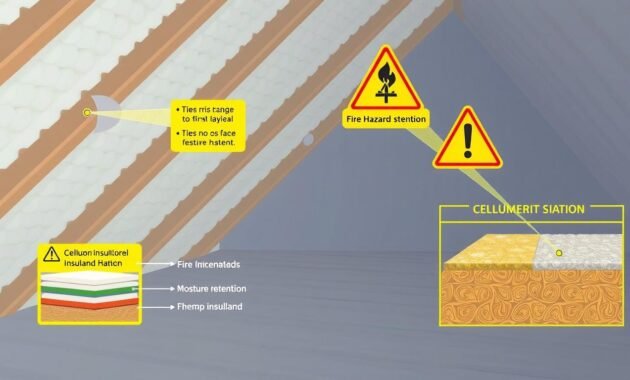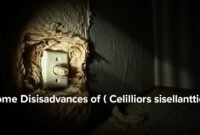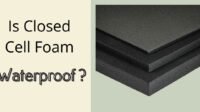Ever worried about the safety of cellulose insulation? I did. The idea of recycled paper in my walls scared me. What if it catches fire? Or attracts mold? These thoughts kept me awake.
But then, I found out some interesting facts about cellulose insulation safety. In this article, I’ll share what I learned. This will help you decide if it’s safe for your home.
Key Takeaways
- Cellulose insulation is made from recycled paper treated with fire retardants
- It’s an eco-friendly option with excellent insulating properties
- Proper installation is crucial for safety and effectiveness
- Fire resistance and moisture management are key safety considerations
- Compared to other insulation materials, cellulose has unique benefits and drawbacks
What is Cellulose Insulation? Composition and Function
Cellulose insulation is a top pick for those wanting to save energy. It’s made from recycled stuff like old newspapers. This recycled paper turns into tiny fibers, making it great for insulating homes.
It’s especially good for attics. Blown in, it creates a thick layer. This layer keeps homes warm in winter and cool in summer. It really cuts down on energy costs and makes homes more comfortable.
Read also: Does Attic Insulation Help in Summer
How Cellulose Insulation Works
Cellulose insulation traps air in its fibers. This air barrier slows down heat transfer. It’s not just for attics; it can also fill wall cavities for better insulation all over the house.
Here’s a quick summary of cellulose insulation’s main points:
- Made from up to 85% recycled paper products
- Treated with fire-retardant chemicals for safety
- Can be installed in both new construction and existing homes
- Offers good sound insulation properties
Cellulose insulation is perfect for those wanting to save energy and help the planet. Its ability to insulate in different ways makes it a versatile choice.
Read also: Basement Ceiling Sound Insulation
Manufacturing and Treatment of Cellulose Insulation
Cellulose insulation is a favorite among eco-friendly homeowners. Knowing how it’s made helps us make better choices for our homes.
From Paper to Insulation
The making of cellulose insulation begins with recycled stuff. Newspapers, cardboard, and more get a second chance as insulation. Here’s the process:
- Collection of recycled paper
- Shredding into small pieces
- Fiberizing to create a fluffy material
- Adding fire-resistant chemicals
- Packaging for distribution
Enhancing Fire Resistance
Fire safety is key for any insulation. Cellulose insulation gets special treatments to boost its fire resistance. The main treatment is boric acid. It fights fires, keeps pests away, and stops mold.
| Treatment | Purpose | Effectiveness |
|---|---|---|
| Boric Acid | Fire resistance | High |
| Ammonium Sulfate | Fire retardant | Moderate |
| Borax | Pest control | Moderate |
Cellulose insulation is safe and green thanks to recycled materials and fire treatments. Its making process is both eco-friendly and effective.
Types of Cellulose Insulation Available
There are two main types of cellulose insulation: loose fill and dense-pack cellulose. Homeowners often choose these for their attics and walls. Let’s look at each type and their uses.
Loose Fill vs Dense-Pack Cellulose
Loose fill cellulose insulation is blown in and settles naturally. It’s great for attics because it can be evenly spread. Dense-pack cellulose, however, is blown into wall cavities with force. This makes it fit tighter.
Benefits and Drawbacks
Each type has its own advantages and disadvantages. Here’s a summary:
| Type | Benefits | Drawbacks |
|---|---|---|
| Loose Fill | Easy to install in attics, affordable, settles well around obstacles | Can settle over time, reducing R-value |
| Dense-Pack | Higher R-value per inch, resists settling, ideal for walls | More expensive, needs professional installation |
Blown in cellulose insulation is effective in both attics and walls. The choice between loose fill and dense-pack depends on the area and budget. Loose fill is good for open spaces like attics. Dense-pack is better for walls because it offers more coverage and insulation.
Health and Safety Concerns
Is cellulose insulation safe to breathe? This is a key question for anyone thinking about using it in their home. Let’s explore the health and safety of this popular insulation material.
Respiratory Effects
Cellulose insulation can release small particles into the air during installation or if disturbed. These particles might irritate the respiratory system. People with asthma or allergies should be extra cautious. It’s important to note that once properly installed, the risk of exposure significantly decreases.

Dust and Chemical Concerns
One of the cellulose insulation dangers is the dust it can create. During installation, proper protective gear is essential. The chemicals used to treat cellulose insulation for fire resistance also raise questions. Some wonder, is cellulose insulation toxic? While the treated material is generally considered safe, it’s wise to minimize direct contact and inhalation.
| Concern | Risk Level | Mitigation |
|---|---|---|
| Dust Inhalation | Moderate | Wear masks during installation |
| Chemical Exposure | Low | Ensure proper installation |
| Long-term Health Effects | Minimal | Regular home maintenance |
I believe that with proper installation and safety measures, the health risks associated with cellulose insulation can be significantly reduced. It’s always best to consult with professionals and follow safety guidelines to ensure a healthy living environment.
Fire Safety: Is Cellulose Insulation Flame Resistant?
Home insulation and fire safety go hand in hand. Many wonder, “Is cellulose insulation flammable?” The truth is more complex than a simple yes or no. Let’s explore cellulose insulation’s fire resistance and its role as a potential fire hazard.
Performance in Fire Resistance Tests
Cellulose insulation is tested thoroughly for fire resistance. It usually does well, sometimes better than synthetic options. Its treatment process helps it withstand high temperatures and slow down flame spread.
Fire-Retardant Treatments
Manufacturers add fire-retardant chemicals to cellulose insulation. These include boric acid and ammonium sulfate. They create a barrier against flames. When heat hits, these chemicals release water, smothering flames.
While not fireproof, cellulose insulation’s treatments greatly lower fire risk. The treated fibers char instead of burning, helping to contain fires. This can prevent fires from spreading quickly through walls and attics.
It’s vital to install cellulose insulation correctly for its fire resistance to hold up. When installed by pros, it makes homes safer. It gives homeowners peace of mind about fire safety.
Moisture Management and Mold Prevention
Cellulose insulation is key for a healthy attic. It’s important to know how it handles moisture to prevent mold.
Water Absorption Rates
Cellulose insulation can soak up moisture, which is both good and bad. It helps control humidity in attics. But too much moisture can make it settle and lose its effectiveness.
| Moisture Content | Effect on Insulation |
|---|---|
| 0-15% | Optimal performance |
| 15-25% | Reduced efficiency |
| 25%+ | Risk of mold growth |
Drying Capabilities
But cellulose insulation dries out well. With good air flow, it can get rid of moisture. This is crucial for keeping mold away from your attic.
To keep mold at bay, check your attic often. Watch for water damage or too much humidity. Good air flow and fixing leaks fast can help a lot.
Installation Considerations
Proper installation of blown in cellulose insulation is crucial. I’ve seen how a good job can greatly improve your home’s comfort and energy use.
Professional vs DIY Installation
While DIY might be tempting, hiring a pro usually gives better results. Experts have the right tools and skills to install insulation correctly. They can also find and fix any problems quickly.
| Professional Installation | DIY Installation |
|---|---|
| Expertise in handling equipment | Learning curve with equipment |
| Efficient and thorough coverage | Potential for uneven application |
| Warranty on work | No warranty |
Safety Equipment and Best Practices
Safety is a top priority. When installing cellulose insulation, wear protective gear like respirators, goggles, and gloves. Make sure there’s good ventilation and follow the manufacturer’s instructions carefully.
Common Installation Mistakes
Avoid these common mistakes for the best results:
- Blocking attic vents
- Compressing the insulation
- Neglecting air sealing before installation
- Inconsistent coverage depth
By avoiding these mistakes, you’ll get the most out of your blown in cellulose insulation in your attic.
Comparing Cellulose Insulation to Other Materials
Choosing the right insulation is key. Cellulose, fiberglass, and foam each have their own benefits. It’s important to think about what works best for you.
Cellulose vs Fiberglass Insulation
Cellulose and fiberglass are top picks for many. Cellulose is from recycled paper, and fiberglass is from glass. Blown fiberglass covers well, but cellulose seals air better.
Performance and Safety Considerations
Both cellulose and fiberglass have safety points. Cellulose fights fires well because of fire retardants. Fiberglass is also fire-resistant but can irritate skin when installed.
| Insulation Type | R-Value per Inch | Fire Resistance | Moisture Resistance |
|---|---|---|---|
| Cellulose | 3.2 – 3.8 | Good | Fair |
| Fiberglass | 2.2 – 2.7 | Excellent | Good |
| Spray Foam | 3.6 – 6.5 | Fair | Excellent |
Foam insulation, like spray foam, seals air and moisture well. It’s very efficient but costs more. I look at climate, budget, and home needs to pick the best insulation.
Environmental Impact and Sustainability
Cellulose insulation is a top pick for eco-friendly building materials. It’s made from up to 85% recycled paper. This gives old materials a new life, avoiding landfills.
Read also: Cheapest Way to Insulate a Metal Building
Recycled Content and Sustainability
Using recycled paper in cellulose insulation cuts down on waste and saves resources. It supports a circular economy and lowers the need for new materials. This makes it a great choice for green building.
Carbon Footprint and Energy Savings
Cellulose insulation also has a smaller carbon footprint. It needs less energy to make than other insulations. After installation, it helps save on heating and cooling costs.
| Insulation Type | Recycled Content | Energy Savings | Carbon Footprint |
|---|---|---|---|
| Cellulose | Up to 85% | High | Low |
| Fiberglass | 20-30% | Moderate | Moderate |
| Spray Foam | 0% | High | High |
Choosing cellulose insulation is wise for those wanting to lessen their environmental impact. It’s both eco-friendly and effective, making it ideal for green building projects.
End-of-Life Considerations
When it’s time to replace or remove cellulose insulation, homeowners often wonder about its fate. I’ve looked into the process and found some interesting insights about insulation removal and its environmental impact.
Removal Process
Removing cellulose insulation involves using specialized vacuuming equipment. This process can be messy, creating dust and requiring protective gear. It’s best left to professionals who have the right tools and know-how to handle the job safely.
Recycling Possibilities
The good news is that cellulose insulation, made from recycled materials, can often be recycled again. Some companies collect and process used cellulose to create new insulation products. This circular approach reduces waste and supports sustainability efforts.
| Disposal Method | Environmental Impact | Feasibility |
|---|---|---|
| Recycling | Low | High |
| Landfill | Moderate | Moderate |
| Incineration | High | Low |
Environmental Considerations
If recycling isn’t an option, cellulose insulation can be disposed of in landfills. While not ideal, it breaks down more easily than synthetic materials. The fire retardants used in cellulose can raise concerns, but their environmental impact is generally considered minimal compared to other insulation types.

By choosing cellulose insulation, you’re supporting a product made from recycled materials that can potentially be recycled again. This creates a more sustainable cycle in home insulation.
Final Thoughts
I’ve looked into cellulose insulation safety and found it’s a good option for many homeowners. It’s made from recycled materials and helps save energy. But, it’s important to consider both the good and bad sides before making a choice.
Key Safety Points
Cellulose insulation is generally safe when installed correctly. It’s treated with borate to make it fire-resistant, adding safety to your home. However, it’s key to manage moisture well to avoid mold and keep it working right.
Recommendations for Homeowners
If you’re thinking about cellulose insulation, get a professional to install it. They’ll make sure it’s done right, saving you energy and avoiding problems. The right insulation can really improve your home’s comfort and efficiency.
In conclusion, cellulose insulation is a good mix of performance, safety, and being eco-friendly. Knowing its benefits and taking the right steps can help you decide if it’s right for your home.


